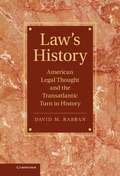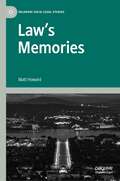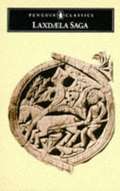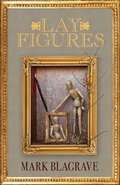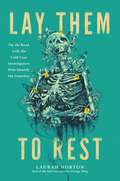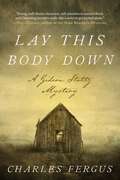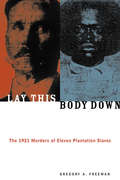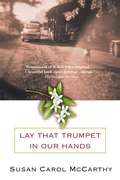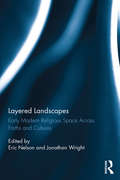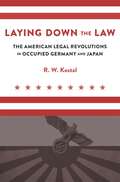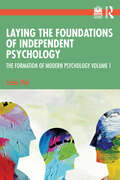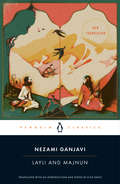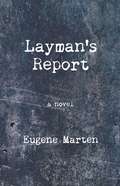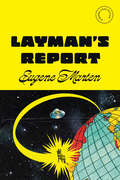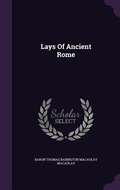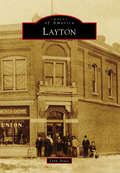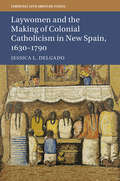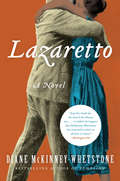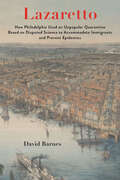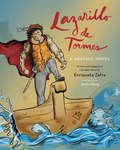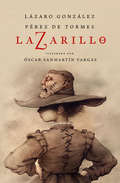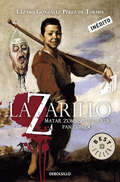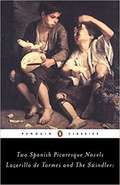- Table View
- List View
Law’s History
by David M. RabbanThis is a study of the central role of history in late nineteenth-century American legal thought. In the decades following the Civil War, the founding generation of professional legal scholars in the United States drew from the evolutionary social thought that pervaded Western intellectual life on both sides of the Atlantic. Their historical analysis of law as an inductive science rejected deductive theories and supported moderate legal reform, conclusions that challenge conventional accounts of legal formalism. Unprecedented in its coverage and its innovative conclusions about major American legal thinkers from the Civil War to the present, the book combines transatlantic intellectual history, legal history, the history of legal thought, historiography, jurisprudence, constitutional theory and the history of higher education.
Law’s Memories (Palgrave Socio-Legal Studies)
by Matt HowardThis book discusses the relationship between law and memory and explores the ways in which memory can be thought of as contributing to legal socialization and legal meaning-making. Against a backdrop of critical legal pluralism which examines the distributedness of law(s), this book introduces the notion of mnemonic legality. It emphasises memory as a resource of law rather than an object of law, on the basis of how it substantiates senses of belonging and comes to frame inclusions and exclusions from a national community on the basis of linear-trajectory and growth narratives of nationhood. Overall, it explores the sensorial and affective foundations of law, implicating memory and perceptions of belonging within this process of creating legality and legitimacy. By identifying how memory comes to shape and inform notions of law, it contributes to legal consciousness research and to important questions informing much socio-legal research.
Laxdaela Saga
by Magnus Magnusson Hermann PalssonWritten around 1245 by an unknown author, the Laxdaela Saga is a tale of conflicting kinships and passionate love, a compelling work of Icelandic literature.
Lay Figures
by Mark BlagraveElizabeth MacKinnon moves to Saint John New Brunswick in 1939 to find inspiration for her poetry in the bohemian life of the city's central peninsula. Swept up in the vibrant society of the city's poets, painters, potters, dancers, and playwrights, she finds herself joining their struggles to make sense of making art in a time of economic depression. Inhabiting the lives of the artists who find themselves in the port city taking refuge from the Depression, Lay Figures explores relationships between art and lived experience, artist and subject, artist and audience, and between margins and centre, and traces the development of a young female writer against the backdrop of the Depression and early war years in Saint John. In a story that couples bitter despair with exuberant triumphs, Elizabeth and her fellow artists make life-changing discoveries about politics and social responsibility, desire and betrayal.
Lay Them to Rest: On the Road with the Cold Case Investigators Who Identify the Nameless
by Laurah NortonTake a fascinating deep dive into the dark world of forensic science as experts team up to solve the identity of an unknown woman by exploring the rapidly evolving techniques being used to break the most notorious cold cases. Fans of true crime shows like CSI, NCIS, Criminal Minds, and Law and Order know that when it comes to &“getting the bad guy&” behind bars, your best chance of success boils down to the strength of your evidence—and the forensic science used to obtain it. Beyond the silver screen, forensic science has been used for decades to help solve even the most tough-to-crack cases. In 2018, the accused Golden State Killer, Joseph DeAngelo, was finally apprehended after a decades-long investigation thanks to a very recent technique called forensic genealogy, which has since led to the closure of hundreds of cold cases, bringing long-awaited justice to victims and families alike. But when it comes to solving these incredibly difficult cases, forensic genealogy is just the tip of the iceberg—and many readers have no idea just how far down that iceberg goes. For Laurah Norton, forensic science was always more of a passion than anything else. But after learning about a mishandled 1990s cold case involving missing twins, she was spurred to action, eventually creating a massively popular podcast and building a platform that helped bring widespread attention and resources to the case. LAY THEM TO REST builds on Laurah&’s fascination with these investigations, introducing readers to the history and evolution of forensic science, from the death masks used in Ancient Rome to the 3-D facial reconstruction technology used today. Incorporating the stories of real-life John & Jane Does from around the world, Laurah also examines how changing identification methods have helped solve the most iconic cold cases. Along the way readers will also get to see Laurah solve a case in real time with forensic anthropologist Dr. Amy Michael, as they try to determine the identity of &“Ina&” Jane Doe, a woman whose head was found in a brush in an Illinois park in 1993. More than just a chronicle of the history of forensics, LAY THEM TO REST is also a celebration of the growing field of experts, forensic artists, and anthropologists (many of whom Laurah talks to in the book), who work tirelessly to bring closure to these unsolved cases. And of course, this book asks why some cases go unsolved, highlighting the &“missing missing,&” the sex workers, undocumented, the cases that so desperately need our attention, but so rarely get it. Engrossing, informative, heartbreaking, and hopeful, LAY THEM TO REST is a deep dive into the world of forensic science, showing readers how far we&’ve come in cracking cases and catching killers, and illuminating just how far we have yet to go.
Lay This Body Down: A Gideon Stoltz Mystery (Gideon Stoltz Mystery Series)
by Charles Fergus"Richly textured historical fiction with the urgency of a mystery novel. Fergus knows certain things, deep in the bone: horses, hunting, the folkways of rural places, and he weaves this wisdom into a stirring tale.&” – Geraldine Brooks, author of March and People of the Book and HorseLay This Body Down, the third Gideon Stoltz Mystery, takes place in 1837 during one of the most horrific periods in pre-Civil War America, when human beings were considered chattel and both northern and southern states grew rich from slave labor. A Pennsylvania sheriff like Gideon could choose to uphold the federal Fugitive Slave Act of 1793 or defy that racist law at great peril. In this hard-hitting, action-packed novel, Gideon tries to protect a boy who has fled north from a Virginia plantation – and pays dearly for his principles. Written with the vivid, atmospheric prose that imbues the whole series, the life and times of an early American backwoods town and its hardscrabble citizens will grip readers as Gideon and his wife True solve a murder, bust a kidnapping ring, and help one unforgettable boy who courageously chooses freedom above all else.
Lay This Body Down: The 1921 Murders of Eleven Plantation Slaves
by Gregory A. FreemanThe John S. Williams plantation in Georgia was operated largely with the labor of slaves--and this was in 1921, 56 years after the Civil War. Williams was not alone in using "peons," but his reaction to a federal investigation was almost unbelievable: he decided to destroy the evidence. Enlisting the aid of his trusted black farm boss, Clyde Manning, he began methodically killing his slaves. As this true story unfolds, each detail seems more shocking, and surprises continue in the aftermath, with a sensational trial galvanizing the nation and marking a turning point in the treatment of black Americans.
Lay that Trumpet in our Hands
by Susan MccarthyIn 1951, Florida suffers many Ku Klux Klan attacks. After her friend is killed, 12-year-old Reesa struggles to understand racism. Eventually, Reesa's home and family become the unofficial center of the resistance movement.
Layered Landscapes: Early Modern Religious Space Across Faiths and Cultures
by Jonathan Wright Eric NelsonThis volume explores the conceptualization and construction of sacred space in a wide variety of faith traditions: Christianity, Hinduism, Islam, Judaism, and the religions of Japan. It deploys the notion of "layered landscapes" in order to trace the accretions of praxis and belief, the tensions between old and new devotional patterns, and the imposition of new religious ideas and behaviors on pre-existing religious landscapes in a series of carefully chosen locales: Cuzco, Edo, Geneva, Granada, Herat, Istanbul, Jerusalem, Kanchipuram, Paris, Philadelphia, Prague, and Rome. Some chapters hone in on the process of imposing novel religious beliefs, while others focus on how vestiges of displaced faiths endured. The intersection of sacred landscapes with political power, the world of ritual, and the expression of broader cultural and social identity are also examined. Crucially, the volume reveals that the creation of sacred space frequently involved more than religious buildings and was a work of historical imagination and textual expression. While a book of contrasts as much as comparisons, the volume demonstrates that vital questions about the location of the sacred and its reification in the landscape were posed by religious believers across the early-modern world.
Layers In Husserl's Phenomonology
by Peter R. CostelloLayers in Husserl's Phenomenology provides close readings and analyses of a number of Husserl's key translated and untranslated works across the entirety of his corpus. While maintaining a dialogue with four decades' worth of scholarship on Husserl, Peter R. Costello provides a number of new and significant insights that depart from earlier interpretations of his work, along with a revised, consistent translation of a number of important Husserlian terms.Layers in Husserl's Phenomenology situates Husserl firmly within the trajectory of later Continental thought and contributes to the recent reconsideration of Husserl as a legitimate precursor to the thought of Maurice Merleau-Ponty, Emmanuel Levinas, and Jacques Derrida. Written in a readable style appropriate for both undergraduate and graduate students, this study will be valued by those interested in phenomenology in general and in Husserl in particular.
Laying Down the Law: The American Legal Revolutions in Occupied Germany and Japan
by R. W. KostalAfter WWII, U.S. leaders sought to create liberal rule-of-law regimes in Germany and Japan, but the effort was often unsuccessful. Kostal argues that the manifest failings of America’s own rule-of-law democracy were partially to blame, weakening U.S. credibility and resolve and revealing the country’s ambiguous status as a global moral authority.
Laying the Foundations of Independent Psychology: The Formation of Modern Psychology Volume 1 (The Formation of Modern Psychology)
by Csaba PléhPart of a two-volume series, this book offers a multicentric perspective on the history of psychology, situating its development in relation to developments made in other social sciences and philosophical disciplines. This first volume, Laying the Foundations of Independent Psychology, provides a detailed exploration of the origins and development of European psychology. The book examines psychology’s beginnings as an independent discipline in the late 19th century through to the emergence of the dominant new schools of behaviorism, Gestalt psychology and psychoanalysis in the early 1900s. This volume also offers a broad overview of the early impact of Darwinism, not only on the psychological study of individual differences and on American functionalism, but also on the early evolutionary treatments of cognition in William James, James Baldwin, Ernst Mach and even Sigmund Freud. Taking this wider perspective, the book shows that European psychology was continuously present and active, placing these European developments in their own context in their own time. An invaluable introductory text for undergraduate students of the history of psychology, the book will also appeal to postgraduates, academics and those interested in psychology or the history of science, as well as graduate students of psychology, biology, sociology and anthropology with a theoretical interest.
Layli and Majnun
by Nezami GanjaviThe Persian epic that inspired Eric Clapton's unforgettable love song "Layla" and that Lord Byron called "the Romeo and Juliet of the East," in a masterly new translationA Penguin ClassicThe iconic love story of the Middle East, by a twelfth-century Persian poet who has been compared to Shakespeare for his subtlety, inventiveness, and dramatic force, Layli and Majnun tells of star-crossed lovers whose union is tragically thwarted by their families and whose passion continues to ripple out across the centuries. Theirs is a love that lasts a lifetime, and in Nezami's immortal telling, erotic longing blends with spiritual self-denial in an allegory of Sufi aspiration, as the amenities of civilization give way to the elemental wilderness, desire is sublimated into a mystical renunciation of the physical world, and the soul confronts its essence. This is a tour de force of Persian literature, in a translation that captures the extraordinary power and virtuosity of the original.
Layman's Report
by Eugene MartenFred. An ordinary man. Repairs office copiers by day, works on his own inventions by night. Fred. Builds a better electric chair, patents a lethal injection machine, corners the capital punishment market. Fred. Looks for love, finds it in the arms of the Holocaust-denial movement-for better or for worse.Inspired by the life of Fred A. Leuchter, Jr., subject of the Errol Morris documentary, Mr. Death, Layman's Report starts with the truth and takes it where only great fiction can.Eugene Marten is the author of Waste, In the Blind, and Firework. He resides in South Dakota.
Layman's Report
by Eugene MartenA disturbing, darkly funny fictionalization of the life of Fred A. Leuchter, the garage tinkerer turned execution authority who became a darling of the neo-Nazi movement, and subject of the Errol Morris documentary, Mr. Death.He comes to fix your photocopier, but really, Fred&’s an inventor. At night, he goes to work. He has goals, ambitions, and when offered the task of building a better electric chair, he jumps at the chance. People have to die—he believes in the occasional necessity of evil—but what if we could kill them more humanely?A death specialist, first in his field but forever under-appreciated, he&’s charmed when a new generation of fascists come calling for his expertise. A Holocaust denier is on trial in Toronto—could Fred prove the gas chambers never existed? Newspapers descend. Talking heads have their say. A documentarist makes a film. Everyone will know his name, though some things society will simply not abide. Dishonoured, discredited, disgraced. But Fred&’s work does not stop, and the world may yet be reminded of the dangerous truth that some men are driven by forces far more powerful than shame. First published in 2013, this is the updated and definitive edition of Eugene Marten&’s chilling masterwork of transformational historical fiction.
Lays of Ancient Rome
by Thomas Babington MacaulayThis antique book is a collection of critical and historical essays by Lord Macaulay. Included are works from ancient Rome.
Layton (Images of America)
by Lynn AraveLayton was settled in 1850 by pioneers in the Church of Jesus Christ of Latter-day Saints. An outgrowth of Kaysville, Layton separated in 1902 following a 20-year legal battle. The city incorporated in 1920. The Layton Sugar Plant opened in 1915, and the town was an agricultural and ranching hub until 1941, when the United States entered World War II. In less than 10 years, by 1950, Layton's population had tripled, mainly because of Hill Field, a US Air Force maintenance base. Today, Layton is the largest city in Davis County and a regional retail center, anchored by the Layton Hills Mall. It is well known for its "Restaurant Row;" Commons Park, which boasts an extensive collection of lighted animal figures during the holidays; the Ed Kenley Amphitheater; the Adams Canyon trail; and much more.
Laywomen and the Making of Colonial Catholicism in New Spain, 1630–1790 (Cambridge Latin American Studies #110)
by Jessica L. DelgadoIn the first history of laywomen and the church in colonial Mexico, Jessica L. Delgado shows how laywomen participated in and shaped religious culture in significant ways by engaging creatively with gendered theology about women, sin, and guilt in their interactions with church sacraments, institutions, and authorities. Taking a thematic approach, using stories of individuals, institutions, and ideas, Delgado illuminates the diverse experiences of urban and rural women of Indigenous, Spanish, and African descent. By centering the choices these women made in their devotional lives and in their relationships to the aspects of the church they regularly encountered, this study expands and challenges our understandings of the church's role in colonial society, the role of religion in gendered and racialized power, and the role of ordinary women in the making of colonial religious culture.
Lazare and Sadi Carnot
by Raffaele Pisano Charles C. GillispieLazare Carnot was the unique example in the history of science of someone who inadvertently owed the scientific recognition he eventually achieved to earlier political prominence. He and his son Sadi produced work that derived from their training as engineering and went largely unnoticed by physicists for a generation or more, even though their respective work introduced concepts that proved fundamental when taken up later by other hands. There was, moreover, a filial as well as substantive relation between the work of father and son. Sadi applied to the functioning of heat engines the analysis that his father had developed in his study of the operation of ordinary machines. Specifically, Sadi's idea of a reversible process originated in the use his father made of geometric motions in the analysis of machines in general. This unique book shows how the two Carnots influenced each other in their work in the fields of mechanics and thermodynamics, and how future generations of scientists have further benefited from their work.
Lazaretto: A Novel
by Diane Mckinney-WhetstoneThis stunning new novel from Diane McKinney-Whetstone, nationally bestselling author of Tumbling, begins in the chaotic backstreets of post-Civil War Philadelphia as a young black woman gives birth to a child fathered by her wealthy white employer.In a city riven by racial tension, the father's transgression is unforgivable. He has already arranged to take the baby, so it falls to Sylvia, the midwife's teenage apprentice, to tell Meda that her child is dead--a lie that will define the course of both women's lives. A devastated Meda dedicates herself to working in an orphanage and becomes a surrogate mother to two white boys; while Sylvia, fueled by her guilt, throws herself into her nursing studies and finds a post at the Lazaretto, the country's first quarantine hospital, situated near the Delaware River, just south of Philadelphia.The Lazaretto is a crucible of life and death; sick passengers and corpses are quarantined here, but this is also the place where immigrants take their first steps toward the American dream. The live-in staff are mostly black Philadelphians, and when two of them arrange to marry, the city's black community prepares for a party on its grounds. But the celebration is plunged into chaos when gunshots ring out across the river.As Sylvia races to save the victim, the fates of Meda's beloved orphans also converge on the Lazaretto. Long ago, one "brother" committed an unthinkable act to protect the other, sparking a chain of events that now puts the Lazaretto on lockdown. Here conflicts escalate, lies collapse, and secrets begin to surface; like dead men rising, past sins cannot be contained.
Lazaretto: How Philadelphia Used an Unpopular Quarantine Based on Disputed Science to Accommodate Immigrants and Prevent Epidemics
by David S. BarnesHow the controversial practice of quarantine saved nineteenth-century Philadelphia after a series of deadly epidemics.In the 1790s, four devastating yellow fever epidemics threatened the survival of Philadelphia, the nation's capital and largest city. In response, the city built a new quarantine station called the Lazaretto downriver from its port. From 1801 to 1895, a strict quarantine was enforced there to protect the city against yellow fever, cholera, typhus, and other diseases. At the time, the science behind quarantine was hotly contested, and the Board of Health in Philadelphia was plagued by internal conflicts and political resistance. In Lazaretto, David Barnes tells the story of how a blend of pragmatism, improvisation, and humane care succeeded in treating seemingly incurable diseases and preventing further outbreaks.Barnes shares the lessons of the Lazaretto through a series of tragic and inspiring true stories of people caught up in the painful ordeal of quarantine. They include a nine-year-old girl enslaved in West Africa and freed upon arrival in Philadelphia, an eleven-year-old orphan boy who survived yellow fever only to be scapegoated for starting an epidemic, and a grieving widow who saved the Lazaretto in the midst of catastrophe. Spanning a turbulent century of immigration, urban growth, and social transformation, Lazaretto takes readers inside the life-and-death debates and ordinary heroism that saved Philadelphia when its survival as a city was at stake. Amid the controversy and tragedy of the COVID-19 pandemic, this surprising reappraisal of America's historic struggle against deadly epidemics reminds us not to neglect old knowledge and skills in our rush to embrace the new.
Lazarillo de Tormes: A Graphic Novel (Toronto Iberic)
by Enriqueta ZafraThis is the first graphic novel adaptation of Lazarillo de Tormes, an anonymous sixteenth-century work that is credited with founding the literary genre of the picaresque novel. This genre includes not only works by Spanish authors like Miguel de Cervantes but also famous novels in English and American literature featuring the "anti-hero." This translated and modern retelling of Lazarillo de Tormes offers a new approach to old questions about a book that has puzzled readers and critics alike for centuries. Who was its mysterious author? Why did the Inquisition forbid this seemingly harmless book? Who read the book and how was it understood? These and other questions are recreated in the graphic novel, offering a broader vision of the fortunes and adversities of a book that against all odds became a literary classic.
Lazarillo Z (edición ilustrada)
by Lázaro González Pérez de TormesEdición ilustrada de Lazarillo Z, una relectura única de la vida y obra de Lázaro González Pérez de Tormes contada por él mismo. Por fin ve la luz lo que jamás te enseñaron en la escuela, la verdadera historia de Lázaro de Tormes, contada por él mismo: De cómo ciertas criaturas se empeñaban en no descansar en paz. De cómo Lázaro se unió a un escuadrón de asalto paranormal. De cómo sobrevivió en un país con mucho hideputa suelto (de ultratumba y de más acá). De cómo, en resumidas cuentas, Lázaro de Tormes se convirtió en uno de los mayores cazadores de zombis del Imperio, y de los problemas que esto le trajo con la Corte y la Santa Inquisición. Reseña:«Plus ultra.»Carlos I de España y V de Alemania
Lazarillo Z: Matar zombis nunca fue pan comido
by Lázaro González Pérez de TormesLa verdadera historia de Lázaro de Tormes: el relato en primera persona de quien fue un personaje central para combatir la plaga zombi que asoló España en el siglo XVI. Por fin ve la luz lo que jamás te enseñaron en la escuela, la verdadera historia de Lázaro de Tormes, contada por él mismo: De cómo ciertas criaturas se empeñaban en no descansar en paz. De cómo Lázaro se unió a un escuadrón de asalto paranormal. De cómo sobrevivió en un país con mucho hideputa suelto (de ultratumba y de más acá). De cómo, en resumidas cuentas, Lázaro de Tormes se convirtió en uno de los mayores cazadores de zombis del Imperio, y de los problemas que esto le trajo con la Corte y la Santa Inquisición. Reseña:«Plus ultra.»Carlos I de España y V de Alemania.
Lazarillo de Tormes and the Swindler: Two Spanish Picaresque Novels (Penguin Classics)
by Francisco De QuevedoThe unlikely heroes of the Spanish picaresque novels make their way - by whatever means they can - through a colourful and seamy underworld populated by unsavoury beggars, corrupt priests, eccentrics, whores and criminals. Both Lazarillo de Tormes and Pablos and the swindler are determined to attain the trappings of the gentleman, but have little time for the gentlemanly ideals of religion, justice, honour and nobility.
